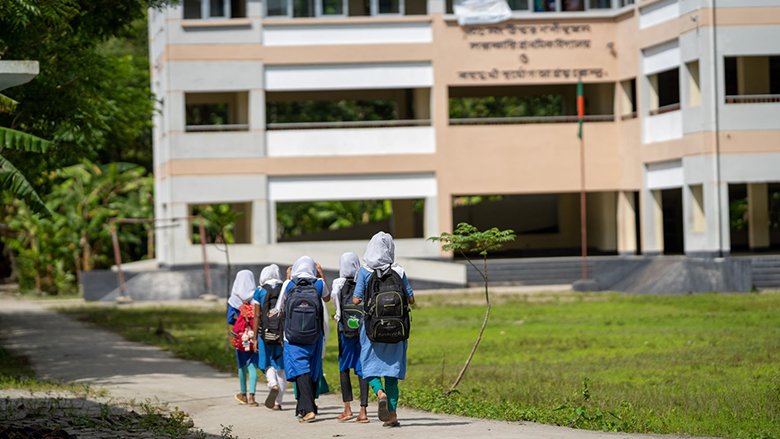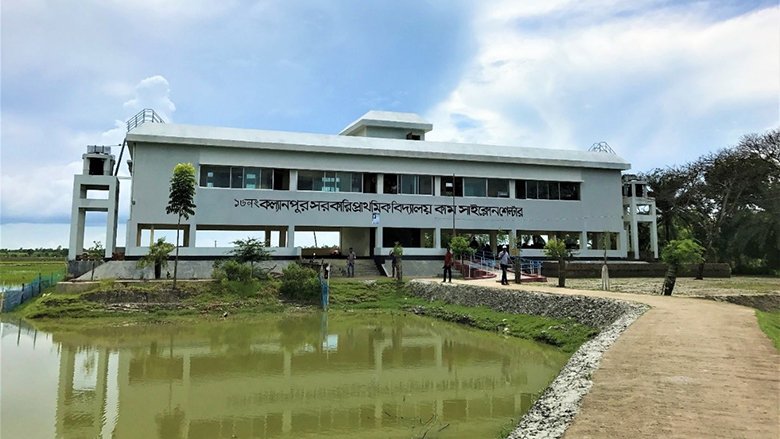Challenge
Bangladesh’s geographical position and its proximity to the Bay of Bengal and the Indian Ocean create a tropical monsoon-type climate, which is prone to cyclones, flooding, and droughts. Nearly 40 million people live on the 710 km-wide coastal plain. Construction of the shelters and building up the defenses of the polders, or islands, has helped mitigate the impacts of these hazards. In 1970 Cyclone Bhola killed about 300,000 people; in 2007 Cyclone Sidr killed 3,500 people; in 2018 Cyclone Fani claimed fewer than 10 lives, and in 2020 Cyclone Amphan killed around 20 people. The Government estimates that over 7,000 multipurpose shelters will be needed by 2025 to improve disaster resilience across a total of 19 coastal districts.
Approach
The Bank-supported MDSP, which has been under way since 2015, has focused on constructing and improving existing disaster shelters, which serve as primary schools at times of regular weather conditions. The project is also building connecting roads and communication networks ensuring easy accessibility to the shelters. Bangladesh has a long experience in constructing multipurpose disaster shelters, notably through the predecessor Emergency 2007 Cyclone Recovery and Restoration Project which was also supported by the World Bank’s International Development Association (IDA). MDSP is further improving the design of shelters and has been one of the first to introduce steel shelters for greater durability. In 2018 the Government approved the Bangladesh Delta Plan 2100 (BDP2100), which includes cyclone shelters as one of its priority interventions.
Results
- Construction is so far complete on 166 new shelters and 50 km of all-weather access roads; 370 existing shelters have been rehabilitated.
- They provide protection for over 589,400 people and 40,600 livestock in vulnerable coastal communities.
- They also provide over 1,600 new and improved classrooms for more than 150,000 primary school children.
- A further 110 new shelters will be built and 50 others rehabilitated before the next cyclone season in November 2022.
Bank Group Contribution
The Project is financed through a US$375 million IDA credit.
Partners
- The Government of Bangladesh contributes to the IDA financing with an additional US$1.7 million.
- The project implementing agency is the Local Government Engineering Department, which also implements other large-scale rural infrastructure projects.
- Because of the dual function of the shelters, the project closely coordinates with the Ministry of Primary and Mass Education on the shelter locations. Volunteer-based School Management Committees provide an important interface with the local community and the sustainability of smaller maintenance of schools.
- Community preparedness activities are carried out through the Cyclone Preparedness Program, led by the Ministry of Disaster Management and Relief in partnership with the Bangladesh Red Crescent Society.
- In addition, the project coordinates closely with other Development Partners, including Asian Development Bank, KfW, USAID, which are also supporting or have recently supported similar multi-purpose disaster shelter initiatives in coastal Bangladesh.
Moving Forward
The number of disaster shelters is still well below what is needed. Ensuring 100% coverage is a high priority of the Government and the Bank, especially given the increased frequency and intensity of cyclones. Designs are constantly being changed to improve the accessibility and facilities at the buildings, including provisions for pregnant women and people with disabilities, improved water harvesting and storage, and energy efficiency. Innovations in materials, designs and procurement strategies are making it possible to build more, better, and faster. The construction of 500 shelters is the largest simultaneous construction of this kind, and the recent use of steel structures has reduced construction time by around 25%.
Beneficiaries
“We are happy to have a shelter center near our house. We are thankful to the government for providing this facility for us. This area will be developed due to the school cum cyclone shelter. Our children can attend school. And during the time of storm and cyclone, we can stay here. Even a few months ago we have taken shelter in the school building with our cows and goats.”
Aklima Khatun, beneficiary, mother of three, Char Fassion, Bhola

